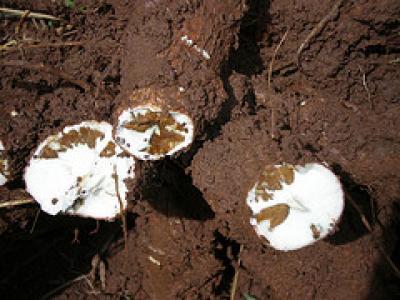ST. LOUIS, MO, August 7, 2012— An international research collaboration recently demonstrated progress in protecting cassava against cassava brown streak disease (CBSD), a serious virus disease, in a confined field trial in Uganda using an RNA interference technology. The field trial was planted in November 2010 following approval by the National Biosafety Committee of Uganda. The plants were harvested in November 2011 and results were published in the August 1, 2012 issue of the journal Molecular Plant Pathology . These results point researchers in the right direction as they develop virus-resistant cassava varieties preferred by farmers in Eastern Africa.
In Sub-Saharan Africa, more than 250 million people derive at least 25 percent of their daily calorie intake from the starchy cassava tuberous roots. In the East African countries of Uganda, Kenya, Tanzania, Mozambique, Rwanda, Burundi and Malawi, 63 percent of households also sell cassava products to earn income for their families. It is estimated that in the next 15 years, cassava will constitute the second most important source of income for more than 125 million people in East Africa.
Cassava brown streak disease is a major problem because it destroys the edible tuberous roots, but visual symptoms on leaves and stems are sometimes difficult to detect. This means unexpected losses for farmers at harvest, with potential devastating impact on families that depend on cassava for food security. Since farmers preserve cassava cuttings in the fields for the next crop, the disease is passed on to the next growing season. Around the Lake Victoria region in Uganda, where an epidemic of the disease is rapidly spreading, many farmers have been forced to abandon the cultivation of cassava. The urgency posed by this disease demands that appropriate tools be employed and interventions applied to solve the problem.
Researchers at the Donald Danforth Plant Science Center and two partner institutions in Africa, the National Crops Resources Research Institute in Uganda (NaCRRI) and the Kenya Agricultural Research Institute (KARI), are working to solve the problem for African farmers through a collaborative project called Virus Resistant Cassava for Africa (VIRCA). The VIRCA project has been developing cassava with enhanced resistance to cassava brown streak disease (CBSD) and cassava mosaic disease (CMD).

These roots are infected with cassava brown streak disease.
(Photo Credit: Donald Danforth Plant Science Center)
"The collaboration is showing progress toward helping smallholder farmers combat these devastating diseases," said Dr. Anton Bua, the Ugandan Cassava Research Team Leader in charge of field trials and communication for the project in East Africa.
"In Uganda, we eat cassava two or three times per day. Restoring and improving cassava productivity will be critical to the continued economic progress of the country and the region," said Dr. Titus Alicai, project lead, National Crop Resources Research Institute (NaCRRI).
Experts with the UN Food and Agriculture Organization (FAO) have expressed concern that CBSD is on the verge of becoming an epidemic in parts of Africa. A press release issued by the FAO last November called for an urgent increase in funding, research, training, surveillance and other measures to help African farmers and breeders. The concern is strong because cassava contributes to household incomes and food security more than any other single crop in some countries.

Women sell cassava at the market in Uganda.
(Photo Credit: Donald Danforth Plant Science Center)